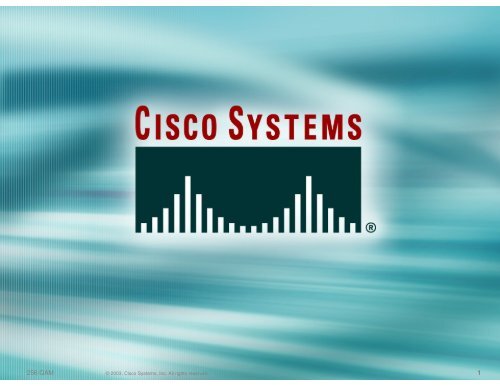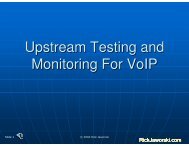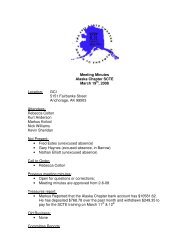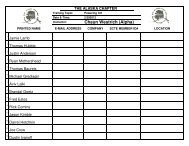1 256-QAM - SCTE - Alaska
1 256-QAM - SCTE - Alaska
1 256-QAM - SCTE - Alaska
You also want an ePaper? Increase the reach of your titles
YUMPU automatically turns print PDFs into web optimized ePapers that Google loves.
<strong>256</strong>-<strong>QAM</strong><br />
© 2003, Cisco Systems, Inc. All rights reserved.<br />
1
<strong>256</strong>-<strong>QAM</strong> in the Downstream<br />
Ron Hranac<br />
rhranacj@cisco.com<br />
<strong>256</strong>-<strong>QAM</strong><br />
© 2003, Cisco Systems, Inc. All rights reserved.<br />
2
Why <strong>256</strong>-<strong>QAM</strong>?<br />
• Higher data throughput<br />
Downstream throughput can be increased by<br />
switching from 64-<strong>QAM</strong> (quadrature amplitude<br />
modulation) to <strong>256</strong>-<strong>QAM</strong><br />
Modulation format<br />
Channel<br />
bandwidth,<br />
MHz<br />
Symbol<br />
rate,<br />
Msym/sec<br />
Raw data<br />
rate,<br />
Mbps<br />
Nominal<br />
data<br />
rate,<br />
Mbps<br />
64-<strong>QAM</strong> (DOCSIS)<br />
6<br />
5.056941<br />
30.34<br />
~27<br />
<strong>256</strong>-<strong>QAM</strong> (DOCSIS)<br />
6<br />
5.360537<br />
42.88<br />
~38<br />
64-<strong>QAM</strong> (Euro-DOCSIS)<br />
8<br />
6.952<br />
41.71<br />
~37<br />
<strong>256</strong>-<strong>QAM</strong> (Euro-DOCSIS)<br />
8<br />
6.952<br />
55.62<br />
~50<br />
<strong>256</strong>-<strong>QAM</strong><br />
© 2003, Cisco Systems, Inc. All rights reserved.<br />
3
First things first<br />
<strong>256</strong>-<strong>QAM</strong> can in most cases be<br />
successfully deployed on a CATV network<br />
if the entire cable system—headend,<br />
distribution network, and subscriber<br />
drops—complies with certain minimum<br />
technical performance specifications.<br />
<strong>256</strong>-<strong>QAM</strong><br />
© 2003, Cisco Systems, Inc. All rights reserved.<br />
4
First things first<br />
Those performance specifications include<br />
relevant government technical regulations<br />
applicable to cable systems—Part 76 of the FCC’s<br />
rules in the case of U.S. cable systems, or<br />
CENELEC Standard EN50083 for European cable<br />
systems—and the recommended parameters in<br />
the Data Over Cable Service Interface<br />
Specification (DOCSIS ® ) Radio Frequency<br />
Interface Specification.<br />
<strong>256</strong>-<strong>QAM</strong><br />
© 2003, Cisco Systems, Inc. All rights reserved.<br />
5
First things first<br />
• The DOCSIS Radio Frequency Interface<br />
Specification is part of the full DOCSIS<br />
specification, which is available at<br />
CableLabs’s Web site:<br />
http://www.cablemodem.com/specifications<br />
• tComLabs also has Euro-DOCSIS<br />
information at its Web site:<br />
http://www.tcomlabs.com/<br />
<strong>256</strong>-<strong>QAM</strong><br />
© 2003, Cisco Systems, Inc. All rights reserved.<br />
6
DOCSIS 1.0 Downstream RF Channel<br />
Transmission Characteristics<br />
Parameter<br />
Frequency range<br />
RF channel spacing (design bandwidth)<br />
Transit delay from headend to most distant<br />
customer<br />
Carrier-to-noise ratio in a 6 MHz band (analog<br />
video level)<br />
Carrier-to-interference ratio for total power<br />
(discrete and broadband ingress signals)<br />
Composite triple beat distortion for analog<br />
modulated carriers<br />
Composite second order distortion for analog<br />
modulated carriers<br />
Cross-modulation level<br />
Amplitude ripple<br />
Group delay ripple in the spectrum occupied by<br />
the CMTS<br />
Micro-reflections bound for dominant echo<br />
Value<br />
Cable system normal downstream operating<br />
range is from 50 MHz to as high as 860 MHz.<br />
However, the values in this table apply only at<br />
frequencies >= 88 MHz.<br />
6 MHz<br />
DOCSIS 1.0 Electrical Input to Cable<br />
Modem<br />
Parameter<br />
Center Frequency<br />
Level Range (one channel)<br />
Modulation Type<br />
Symbol Rate (nominal)<br />
Bandwidth<br />
Total Input Power (40-900 MHz)<br />
Input (load) Impedance<br />
Input Return Loss<br />
Connector<br />
Value<br />
91 to 857 MHz, ±30 kHz<br />
-15 dBmV to +15 dBmV<br />
64-<strong>QAM</strong> and <strong>256</strong>-<strong>QAM</strong><br />
5.056941 Msym/sec (64-<strong>QAM</strong>) and<br />
5.360537 Msym/sec (<strong>256</strong>-<strong>QAM</strong>)<br />
6 MHz (18% Square Root Raised Cosine shaping for 64-<strong>QAM</strong> and<br />
12% Square Root Raised Cosine shaping for <strong>256</strong>-<strong>QAM</strong>)<br />
< 30 dBmV<br />
75 ohms<br />
> 6 dB (88-860 MHz)<br />
F connector per [IPS-SP-406] (common with the output)<br />
<strong>256</strong>-<strong>QAM</strong><br />
© 2003, Cisco Systems, Inc. All rights reserved.<br />
8
DOCSIS 1.0 Upstream RF Channel<br />
Transmission Characteristics<br />
Parameter<br />
Frequency range<br />
Transit delay from the most distant CM to the<br />
nearest CM or CMTS<br />
Carrier-to-noise ratio<br />
Carrier-to-ingress power (the sum of discrete and<br />
broadband ingress signals) ratio<br />
Carrier-to-interference (the sum of noise,<br />
distortion, common-path distortion, and crossmodulation)<br />
ratio<br />
Value<br />
5 to 42 MHz edge to edge<br />
Headend RF Levels—Integrated Upconverter<br />
• Verify correct average power level<br />
Integrated upconverter RF output should be<br />
set in the DOCSIS-specified +50 to +61 dBmV<br />
range<br />
Typical levels are +55 to +58 dBmV<br />
CMTS<br />
To headend downstream<br />
combiner<br />
88-860 MHz downstream<br />
RF output<br />
(+50 dBmV to +61 dBmV)<br />
Attenuator<br />
(if required)<br />
<strong>256</strong>-<strong>QAM</strong><br />
© 2003, Cisco Systems, Inc. All rights reserved.<br />
10
Headend RF Levels—External Upconverter<br />
• Verify correct average power level<br />
CMTS downstream IF output<br />
External upconverter IF input<br />
External upconverter RF output<br />
CMTS<br />
44 MHz downstream<br />
IF output<br />
(e.g., +42 dBmV +/-2 dB)<br />
44 MHz IF input to<br />
upconverter<br />
(typ. +25 dBmV to +35<br />
dBmV)<br />
Attenuator<br />
RF upconverter<br />
88-860 MHz downstream<br />
RF output to CATV network<br />
(+50 dBmV to +61 dBmV)<br />
<strong>256</strong>-<strong>QAM</strong><br />
© 2003, Cisco Systems, Inc. All rights reserved.<br />
11
Headend RF Levels<br />
• DOCSIS recommends that the digitally<br />
modulated carrier’s average power level be<br />
set 6 dB to 10 dB below what the visual<br />
carrier level of an analog TV channel on the<br />
same frequency would be 1<br />
• This ratio should be maintained throughout<br />
the entire cable network<br />
<strong>256</strong>-<strong>QAM</strong><br />
© 2003, Cisco Systems, Inc. All rights reserved.<br />
12
Headend Bit Error Rate Performance<br />
• Check BER at upconverter input and output<br />
Some external upconverters have a very tight<br />
window with regard to IF input and RF output<br />
levels vs. BER<br />
CMTS<br />
Attenuator<br />
RF upconverter<br />
<strong>256</strong>-<strong>QAM</strong><br />
© 2003, Cisco Systems, Inc. All rights reserved.<br />
13
Headend Bit Error Rate Performance<br />
• Check signal levels and BER at downstream laser<br />
input and node output<br />
Bit errors at downstream laser input but not at CMTS or<br />
upconverter output may indicate sweep transmitter<br />
interference, loose connections or combiner problems<br />
Bit errors at node output but not at laser input are most<br />
likely caused by downstream laser clipping<br />
<strong>256</strong>-<strong>QAM</strong><br />
© 2003, Cisco Systems, Inc. All rights reserved.<br />
14
Other DOCSIS RFI Spec Parameters<br />
• 64-<strong>QAM</strong> bit error rate: Cable modem post-FEC<br />
BER must be less than or equal to 10 -8 when<br />
operating at a carrier-to-noise ratio (E S /N 0 ) of<br />
23.5 dB or greater<br />
• <strong>256</strong>-<strong>QAM</strong> bit error rate: CM post-FEC BER<br />
must be less than or equal to 10 -8 when<br />
operating at a CNR (E S /N 0 ) of<br />
30 dB or greater when the input receive signal level<br />
is -6 dBmV to +15 dBmV<br />
33 dB or greater when the input receive signal level<br />
is -6 dBmV down to -15 dBmV<br />
<strong>256</strong>-<strong>QAM</strong><br />
© 2003, Cisco Systems, Inc. All rights reserved.<br />
15
Other Euro-DOCSIS RFI Spec<br />
Parameters<br />
• The nominal power level of the downstream<br />
CMTS <strong>QAM</strong> signal(s) within an 8 MHz channel is<br />
targeted to be in the range -13 dBc to 0 dBc<br />
relative to the analogue video carrier level and<br />
will normally not exceed the analogue video<br />
carrier level (typically between -10 to -6 dBc for<br />
64-<strong>QAM</strong>, and between -6 to -4 dBc for <strong>256</strong>-<strong>QAM</strong>).<br />
• 64-<strong>QAM</strong> bit error rate: Cable modem post-FEC<br />
BER must be less than or equal to 10 -8 when<br />
operating at a CNR (E S<br />
/N 0<br />
) of 25.5 dB or greater<br />
<strong>256</strong>-<strong>QAM</strong><br />
© 2003, Cisco Systems, Inc. All rights reserved.<br />
16
Other Euro-DOCSIS RFI Spec<br />
Parameters<br />
• <strong>256</strong>-<strong>QAM</strong> bit error rate: CM post-FEC BER<br />
must be less than or equal to 10 -8 when<br />
operating at a CNR (E S /N 0 ) of<br />
34.5 dB or greater when the input receive<br />
signal level is 47 dBµV to 54 dBµV<br />
31.5 dB or greater when the input receive<br />
signal level is >54 to +77 dBµV<br />
<strong>256</strong>-<strong>QAM</strong><br />
© 2003, Cisco Systems, Inc. All rights reserved.<br />
17
Digitally Modulated Carrier CNR vs. BER<br />
Modulation<br />
format<br />
1.0E-04<br />
1.0E-06<br />
1.0E-08<br />
1.0E-10<br />
1.0E-12<br />
ASK & FSK<br />
7 dB<br />
9 dB<br />
10 dB<br />
11 dB<br />
12 dB<br />
BPSK<br />
9 dB<br />
11 dB<br />
12 dB<br />
13 dB<br />
14 dB<br />
QPSK<br />
12 dB<br />
14 dB<br />
15 dB<br />
16 dB<br />
17 dB<br />
16-<strong>QAM</strong><br />
19 dB<br />
21 dB<br />
22 dB<br />
23 dB<br />
24 dB<br />
32-<strong>QAM</strong><br />
21 dB<br />
23 dB<br />
24 dB<br />
25 dB<br />
26 dB<br />
64-<strong>QAM</strong><br />
25 dB<br />
27 dB<br />
28 dB<br />
29 dB<br />
30 dB<br />
<strong>256</strong>-<strong>QAM</strong><br />
32 dB<br />
34 dB<br />
35 dB<br />
36 dB<br />
37 dB<br />
<strong>256</strong>-<strong>QAM</strong><br />
© 2003, Cisco Systems, Inc. All rights reserved.<br />
18
Digitally Modulated Carrier CNR vs. BER<br />
<strong>256</strong>-<strong>QAM</strong> requires 6~7 dB better CNR to<br />
achieve the same bit error rate as 64-<br />
<strong>QAM</strong>!!!<br />
Many cable operators transmit 64-<strong>QAM</strong><br />
digitally modulated carriers at -10 dBc<br />
relative to analog TV channels, and increase<br />
the amplitude of <strong>256</strong>-<strong>QAM</strong> digitally<br />
modulated carriers to -5 to -6 dBc.<br />
<strong>256</strong>-<strong>QAM</strong><br />
© 2003, Cisco Systems, Inc. All rights reserved.<br />
19
Downstream Digitally Modulated<br />
Carrier CNR<br />
Courtesy Agilent Technologies and Sunrise Telecom<br />
<strong>256</strong>-<strong>QAM</strong><br />
© 2003, Cisco Systems, Inc. All rights reserved.<br />
20
Downstream Integrity<br />
• How can one keep the forward plant at or<br />
better than the DOCSIS-recommended 35<br />
dB CNR value?<br />
Proper forward and reverse fiber link and coax<br />
plant alignment<br />
Signal leakage and ingress management<br />
Good installation practices<br />
<strong>256</strong>-<strong>QAM</strong><br />
© 2003, Cisco Systems, Inc. All rights reserved.<br />
21
Downstream Integrity<br />
• Minimum recommended<br />
downstream modulation<br />
error ratio (MER)—<br />
includes 3 to 4 dB of<br />
headroom for reliable<br />
operation<br />
64-<strong>QAM</strong>: 27 dB<br />
<strong>256</strong>-<strong>QAM</strong>: 31 dB<br />
• Typical headend or<br />
node MER is 34 to 36 dB<br />
or greater; MER at cable<br />
modem input should be<br />
in the low- to mid-30s<br />
Graphic courtesy of Sunrise Telecom<br />
<strong>256</strong>-<strong>QAM</strong><br />
© 2003, Cisco Systems, Inc. All rights reserved.<br />
22
Downstream Integrity<br />
• Amplitude ripple<br />
In-channel flatness<br />
DOCSIS 1.0 says 0.5 dB “within the design<br />
bandwidth,” but this parameter was relaxed to<br />
3.0 dB in DOCSIS 1.1 and 2.0<br />
<strong>256</strong>-<strong>QAM</strong><br />
© 2003, Cisco Systems, Inc. All rights reserved.<br />
23
Downstream Integrity<br />
Digitally Modulated Carrier In-Channel Flatness<br />
Courtesy Agilent Technologies and Sunrise Telecom<br />
<strong>256</strong>-<strong>QAM</strong><br />
© 2003, Cisco Systems, Inc. All rights reserved.<br />
24
Group Delay<br />
• Group delay is defined in units of time, typically<br />
nanoseconds (ns)<br />
• In a system, network or component with no<br />
group delay, all frequencies are transmitted<br />
through the system, network or component with<br />
equal time delay<br />
• Group delay causes intersymbol interference,<br />
which degrades BER performance<br />
Frequency response problems in a CATV network may<br />
cause group delay<br />
Group delay also is common near band edges or rolloff<br />
areas<br />
<strong>256</strong>-<strong>QAM</strong><br />
© 2003, Cisco Systems, Inc. All rights reserved.<br />
25
Group Delay<br />
DOCSIS-specified<br />
downstream<br />
maximum group<br />
delay ripple in the<br />
spectrum<br />
occupied by the<br />
CMTS is 75 ns<br />
within the design<br />
bandwidth<br />
Graphic courtesy of Sunrise Telecom<br />
<strong>256</strong>-<strong>QAM</strong><br />
© 2003, Cisco Systems, Inc. All rights reserved.<br />
26
System performance<br />
• Forward and reverse properly aligned<br />
Sweep alignment is best<br />
• Manage signal leakage and ingress<br />
98 th or 99 th percentile flyover performance<br />
Leaks at or below 5 µV/m (3 meter<br />
measurement distance with half-wave dipole)<br />
<strong>256</strong>-<strong>QAM</strong><br />
© 2003, Cisco Systems, Inc. All rights reserved.<br />
27
System performance<br />
• End-of-line and chassis (KS-port style)<br />
terminators are susceptible to sometimes being<br />
damaged by lightning-induced surges<br />
Resulting impedance mismatches and microreflections<br />
raise havoc with proper two-way operation<br />
• Loose seizure screws on connectors and<br />
terminators may cause microreflections<br />
• Missing or defective tap port and drop passive<br />
terminators also will cause problems<br />
More of an issue on low-value taps and drop passives<br />
• So-called self-terminating taps do not actually<br />
terminate the end-of-line<br />
<strong>256</strong>-<strong>QAM</strong><br />
© 2003, Cisco Systems, Inc. All rights reserved.<br />
28
<strong>256</strong>-<strong>QAM</strong> Checklist<br />
Entire cable network—headend, distribution network and<br />
subscriber drops—DOCSIS-compliant<br />
Upconverter setup, IF input/RF output levels<br />
Downstream laser input levels<br />
Avoid downstream frequencies near band edges or rolloff<br />
areas<br />
Avoid downstream frequencies that may be susceptible to<br />
ingress from strong over-the-air signals 1<br />
Forward and reverse properly aligned<br />
Frequency response flat<br />
Signal leakage and ingress management<br />
Good installation practices<br />
<strong>256</strong>-<strong>QAM</strong><br />
© 2003, Cisco Systems, Inc. All rights reserved.<br />
29
DOCSIS Checklist<br />
Headend (downstream) CMTS or upconverter output<br />
Test performed Parameter<br />
Parameter value Measured value/comments<br />
<br />
CMTS downstream IF output +42 dBmV 1<br />
Digitally modulated carrier<br />
amplitude at upconverter<br />
input<br />
Digitally modulated carrier<br />
amplitude at upconverter<br />
output<br />
Digitally modulated carrier<br />
center frequency<br />
Carrier-to-noise ratio<br />
Modulation error ratio<br />
(MER) 3<br />
Pre-FEC BER 4<br />
Post FEC BER 5<br />
Amplitude ripple (in-channel<br />
flatness)<br />
Group delay ripple<br />
Constellation evaluation<br />
+25 to +35 dBmV 2<br />
+50 to +61 dBmV<br />
91-857 MHz<br />
Not less than 35 dB<br />
64-<strong>QAM</strong>: 27 dB minimum<br />
<strong>256</strong>-<strong>QAM</strong>: 31 dB minimum<br />
N/A<br />
Less than or equal to 10 -8<br />
3 dB 6<br />
75 ns maximum<br />
Look for evidence of gain compression;<br />
phase noise; I-Q imbalance; coherent<br />
interference; excessive noise; and<br />
clipping<br />
<strong>256</strong>-<strong>QAM</strong><br />
© 2003, Cisco Systems, Inc. All rights reserved.<br />
30
DOCSIS Checklist<br />
Headend (downstream) laser transmitter<br />
or first amplifier input, node output<br />
Test performed<br />
Parameter<br />
Parameter value<br />
Measured value/comments<br />
<br />
Digitally modulated carrier<br />
average power level relative<br />
to analog TV channel visual<br />
carrier amplitude<br />
-10 to -6 dBc<br />
Digitally modulated carrier<br />
center frequency<br />
91-857 MHz<br />
Carrier-to-noise ratio<br />
Not less than 35 dB<br />
Modulation error ratio<br />
(MER) 1<br />
64-<strong>QAM</strong>: 27 dB minimum<br />
<strong>256</strong>-<strong>QAM</strong>: 31 dB minimum<br />
Pre-FEC BER 2<br />
N/A<br />
Post FEC BER 3<br />
Less than or equal to 10 -8<br />
Amplitude ripple (in-channel<br />
flatness)<br />
3 dB 4<br />
Group delay ripple<br />
75 ns maximum<br />
Constellation evaluation<br />
Look for evidence of gain compression;<br />
phase noise; I-Q imbalance; coherent<br />
interference; excessive noise; and<br />
clipping<br />
<strong>256</strong>-<strong>QAM</strong><br />
© 2003, Cisco Systems, Inc. All rights reserved.<br />
31
DOCSIS Checklist<br />
Downstream input to cable modem<br />
Test performed<br />
Parameter<br />
Parameter value<br />
Measured value/comments<br />
<br />
Digitally modulated carrier<br />
center frequency<br />
91-857 MHz<br />
Digitally modulated carrier<br />
average power level relative<br />
to analog TV channel visual<br />
carrier amplitude<br />
-10 to -6 dBc<br />
Digitally modulated carrier<br />
average power level 1<br />
-15 to +15 dBmV<br />
Carrier-to-noise ratio<br />
Not less than 35 dB<br />
Total downstream RF input<br />
power 2<br />
DOCSIS Checklist<br />
Downstream input to cable modem (cont’d)<br />
Test performed<br />
Parameter<br />
Parameter value<br />
Measured value/comments<br />
<br />
Constellation evaluation<br />
Look for evidence of gain compression;<br />
phase noise; I-Q imbalance; coherent<br />
interference; excessive noise; and<br />
clipping<br />
Amplitude ripple (in-channel<br />
flatness)<br />
3 dB 4<br />
Hum modulation<br />
5% (-26 dBc)<br />
Maximum analog TV channel<br />
visual carrier level<br />
+17 dBmV<br />
Minimum analog TV channel<br />
visual carrier level<br />
-5 dBmV<br />
Transit delay from CMTS to<br />
most distant cable modem 5<br />
DOCSIS Checklist<br />
CMTS upstream input<br />
Test performed<br />
Parameter<br />
Parameter value<br />
Measured value/comments<br />
<br />
Digitally modulated carrier<br />
bandwidth<br />
200, 400, 800, 1,600 or 3,200 kHz<br />
Digitally modulated carrier<br />
symbol rate<br />
160, 320, 640, 1,280 or 2,560 ksym/sec<br />
Digitally modulated carrier<br />
center frequency<br />
Must be within 5-42 MHz spectrum<br />
Digitally modulated carrier<br />
amplitude 1<br />
-16 to +26 dBmV depending on symbol<br />
rate<br />
Total 5-42 MHz RF spectrum<br />
power<br />
Must not exceed +35 dBmV<br />
Carrier-to-noise ratio<br />
Not less than 25 dB 2<br />
Carrier-to-interference ratio<br />
Not less than 25 dB 2<br />
Carrier-to-ingress power<br />
ratio<br />
Not less than 25 dB 2<br />
<strong>256</strong>-<strong>QAM</strong><br />
© 2003, Cisco Systems, Inc. All rights reserved.<br />
34
DOCSIS Checklist<br />
CMTS upstream input (cont’d)<br />
Test performed<br />
Parameter<br />
Parameter value<br />
Measured value/comments<br />
<br />
Hum modulation<br />
7% (-23 dBc)<br />
Amplitude ripple<br />
0.5 dB/MHz<br />
Group delay ripple 3<br />
200 ns/MHz<br />
Transit delay from most<br />
distant cable modem to<br />
CMTS 4<br />
Presentation_ID<br />
© 2001, Cisco Systems, Inc. All rights reserved.<br />
36





